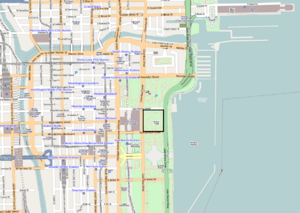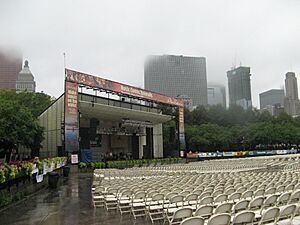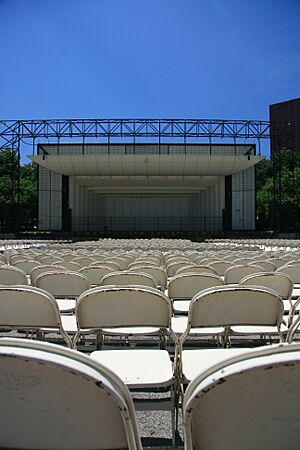Petrillo Music Shell facts for kids
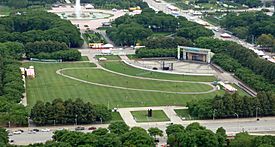
Aerial view of venue (c.2010)
|
|
| Full name | James C. Petrillo Music Shell |
|---|---|
| Former names | Grant Park Band Shell (1931-78) |
| Address | 235 S Columbus Dr Chicago, IL 60604 |
| Location | Grant Park |
| Owner | City of Chicago |
| Capacity | ~35,000
|
| Construction | |
| Broke ground | July 11, 1931 |
| Opened | August 24, 1931 |
| Renovated | 1978 |
| Construction cost | $15,000 ($289 thousand in 2022 dollars ) |
| Architect | E.V. Buchsbaum |
|
Building details
|
|
| General information | |
| Relocated | July 24, 1978 |
| Renovation cost | $2.6 million ($11.7 million in 2022 dollars ) |
| Renovating team | |
| Architect | C.F. Murphy Associates |
| Other designers | Klepper, Marshall & Kings Associates |
The Petrillo Music Shell is an outdoor stage in Grant Park in Chicago, Illinois. It's a famous spot where many big music festivals happen every year. Some of these include the Chicago Blues Festival, Chicago Jazz Festival, Taste of Chicago, and Lollapalooza.
This name has been used for two different buildings. The first one stood from 1931 to 1975. The second, newer one opened in 1978 and is still used today.
The first music shell was built in 1931 by Mayor Anton Cermak. This was during the Great Depression, a time when many people had lost their jobs and money. The mayor wanted to cheer people up with free concerts. In 1975, the music shell was named after James C. Petrillo. He was a leader of musicians' groups and started the free concert series in Grant Park in 1935.
Where is the Music Shell?
In 1915, a temporary wooden stage was set up in Grant Park. It hosted many events for about five or six years. Then, in 1931, Mayor Cermak suggested having free concerts. This was important because new inventions like records and radios meant fewer people were going to live music shows.
A group called the Chicago Concert Band Association offered to put on free summer concerts. But they needed a proper stage with lights and dressing rooms. So, construction began on a new wooden stage. It cost about $12,500 and was finished in just three weeks! The first free concerts started on August 24, 1931.
On July 1, 1935, James C. Petrillo helped start the free concerts in Grant Park at this original stage. It was first called the Grant Park Band Shell. Later, in 1975, it was renamed the Petrillo Music Shell to honor him.
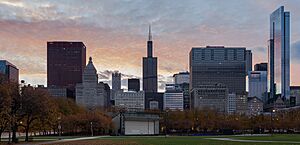
Over the years, there were many ideas to replace the first band shell. By the 1970s, the original stage was falling apart. Performers even joked about needing hard hats because parts of the stage floor were breaking! Even after spending $77,000 on repairs in 1977, musicians thought about canceling the 1978 concert season.
There are old rules about not building tall structures in Grant Park. These rules came from a man named Aaron Montgomery Ward, who wanted to keep the park open and free of buildings. Because of these rules, the city had to be careful about building a new music shell.
In 1972, there were plans for a big new concrete stage. But community groups reminded everyone about the building rules. So, a simpler, less expensive stage was designed. This "semi-permanent" stage opened in 1978 and cost about $3 million. It was built in a way that followed the park's rules.
The Petrillo Music Shell is located at 235 S. Columbus Drive. It's in a large area called Butler Field. This spot is near the Art Institute of Chicago, Buckingham Fountain, and Millennium Park. It's a main stage for big events like Lollapalooza.
History of Performances
Concerts at the music shell began in August 1931. In July 1932, Franklin Delano Roosevelt, who would later become president, visited the band shell during his campaign.
In 1934, many parks in Chicago joined together to get money from the government. Mayor Edward Kelley appointed James C. Petrillo to the Chicago Park District board. Petrillo suggested a series of free symphony concerts in Grant Park. He helped raise money for the first season.
The first Grant Park Music Festival started on July 1, 1935. It had 65 concerts and ran until Labor Day. Famous orchestras like the Chicago Symphony Orchestra performed. Large concert bands also played. By the end of the summer, up to 35,000 people were coming to the free concerts every night. About 1.9 million people attended that summer! Because it was so popular, the Park District decided to pay for the concerts every year. The first season's concerts were even broadcast on national radio.
The band shell was also used for important events during World War II. In July 1942, a celebration for the city's 10,000th United States Navy recruit was held there. In 1944, a public address system was added, and more people started using Grant Park after the war.
In 1958, a famous pianist named Van Cliburn performed at the Grant Park Music Festival. He had just won a major music competition in Moscow, making him internationally famous. His performance was a huge event, and he even had a parade in Chicago! The next year, the band shell hosted concerts for the opening of the 1959 Pan American Games.
Since 1978, the new band shell has hosted many events. These include Taste of Chicago, the annual Independence Day fireworks celebration, and the Chicago Blues, Jazz, and Gospel Festivals. In October 1979, Pope John Paul II led a very large public mass there. Other important figures like the Dalai Lama have also held events at the music shell. It was also the place where the Chicago Bulls celebrated their National Basketball Association championships.
Since 2005, the Petrillo Music Shell has been a main stage for the yearly Lollapalooza festival.


